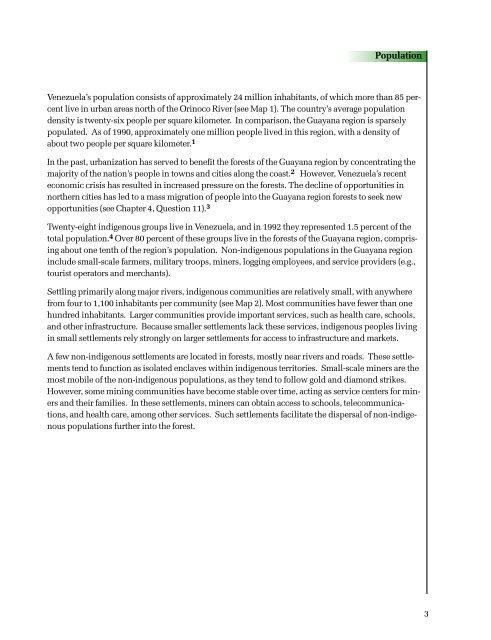Usar pâgs xvii-134 - ResearchGate
Usar pâgs xvii-134 - ResearchGate
Usar pâgs xvii-134 - ResearchGate
Create successful ePaper yourself
Turn your PDF publications into a flip-book with our unique Google optimized e-Paper software.
PopulationVenezuela’s population consists of approximately 24 million inhabitants, of which more than 85 percentlive in urban areas north of the Orinoco River (see Map 1). The country’s average populationdensity is twenty-six people per square kilometer. In comparison, the Guayana region is sparselypopulated. As of 1990, approximately one million people lived in this region, with a density ofabout two people per square kilometer. 1In the past, urbanization has served to benefit the forests of the Guayana region by concentrating themajority of the nation’s people in towns and cities along the coast. 2 However, Venezuela’s recenteconomic crisis has resulted in increased pressure on the forests. The decline of opportunities innorthern cities has led to a mass migration of people into the Guayana region forests to seek newopportunities (see Chapter 4, Question 11). 3Twenty-eight indigenous groups live in Venezuela, and in 1992 they represented 1.5 percent of thetotal population. 4 Over 80 percent of these groups live in the forests of the Guayana region, comprisingabout one tenth of the region’s population. Non-indigenous populations in the Guayana regioninclude small-scale farmers, military troops, miners, logging employees, and service providers (e.g.,tourist operators and merchants).Settling primarily along major rivers, indigenous communities are relatively small, with anywherefrom four to 1,100 inhabitants per community (see Map 2). Most communities have fewer than onehundred inhabitants. Larger communities provide important services, such as health care, schools,and other infrastructure. Because smaller settlements lack these services, indigenous peoples livingin small settlements rely strongly on larger settlements for access to infrastructure and markets.A few non-indigenous settlements are located in forests, mostly near rivers and roads. These settlementstend to function as isolated enclaves within indigenous territories. Small-scale miners are themost mobile of the non-indigenous populations, as they tend to follow gold and diamond strikes.However, some mining communities have become stable over time, acting as service centers for minersand their families. In these settlements, miners can obtain access to schools, telecommunications,and health care, among other services. Such settlements facilitate the dispersal of non-indigenouspopulations further into the forest.3
















